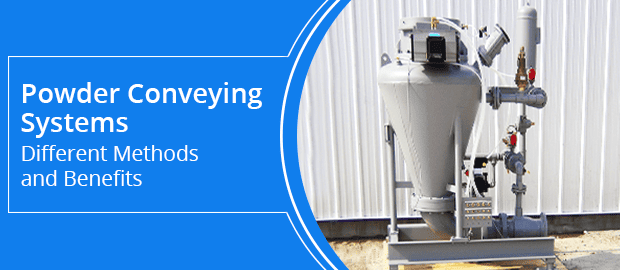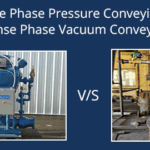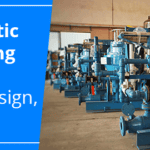While powder conveying systems are highly versatile, choosing the right method that is suitable for your application can be a tough choice. If you want to make the right choice, then learning about the different powder transfer systems is important. Thus, read below to learn about the various conveying methods along with their many benefits.
A] Different Powder Conveying Methods
When it comes to conveyors, there are different systems available namely pneumatic conveying system and mechanical conveying system. Choosing the right conveying method is essential for optimal performance and to ensure quality end-products. To this end, you need to consider a few things such as the material properties, capacity & distance of conveying, and environmental factors to select the best conveying method for your process.
Maximize Productivity with Our Powder Conveying Solutions
1. Pneumatic Powder Conveying Methods
- Dense Phase Conveying Systems: Dense phase conveying systems convey high capacity materials over long distances. They are well-suited for single source or multiple destination systems and helps reduce abrasion & particle degradation. They also offer a continuous conveying option and is compressed-air driven that help reduce the average conveying velocity. These systems are ideal for chemicals, cement, plastic, metals, among others.
- Lean Phase Positive Pressure Systems: This is a blower-driven system that helps move the material through the air and makes use of a rotary valve/airlock feeding device to release the material from the bin. It offers continuous operations and is suitable for less abrasive materials like resins, pelletized products, coffee products, etc. These systems blow materials at higher velocities above its saltation set-point.
Further reading: Difference Between Dense Phase and Dilute Phase Pneumatic Conveying Systems
- Lean Phase Suction Systems: This is a blower-driven system that helps in suction of the material from the feed point to the destination point. Suction is typically done at higher velocities and is ideal for irregular shaped particles or uneven particles.
- Vacuum Conveying Systems: These systems use positive displacement exhausters to provide a vacuum that helps convey materials through the pipeline into the receiving vessel. Upon reaching the receiving vessel, the air and product are filtered and separated. Lean or dilute phase vacuum conveying systems are highly versatile and adaptable and can be used at high or low operating pressures based on the material being conveyed.Vacuum conveying systems can be designed using either rotary blowers, centrifugal blowers or even rotary vane/side channel vacuum pumps and are specially designed for compact applications in the food, chemical, and pharma industries.
2. Mechanical Powder Conveying Methods
- Screw Conveyors: One of the most cost-effective ways to convey materials mechanically, screw conveyors are used for adding minor amounts of powder, unloading bulk bags, discharging small hoppers, and other different types of applications. Screw conveyors can be installed in vertical, horizontal, or inclined arrangement.
- Belt Conveyors: These are used for transporting bulk materials like coal, ore, salt, sand, grain, etc. Belt conveyor systems consist of two or more pulleys – also referred to as drums – with a closed loop of carrying medium (the conveyor belt) that rotates about them.
- Bucket Elevators: Consisting of a series of buckets that is attached to a belt or chain with pulleys, bucket elevators are used to elevate bulk materials vertically.
- Vibrating Conveyors: To convey fragile bulk powder materials, vibrating conveyors are used. These are highly sanitary and gentle system that can help convey dry, wet, frozen as well as abrasive products.
B] How Do They Work?
Being a pneumatic conveying system, a powder transfer system uses both pressure or vacuum to move (convey) materials to & from process machines either vertically or horizontally as if they were liquids. This eliminates the need for gravity charging, making multi-floor processes redundant. These systems are suitable for transferring toxic & hygroscopic materials and highly explosive powders.
It provides a safe, reliable & enclosed method to transfer powder by eliminating oxygen from the powder and provides a separate physical barrier from the reactor, which completely eliminates the risk of explosion, dangerous gas leak or fire when in operation.
As a unique technology, the powder transfer system provides total containment and speeds up production while significantly improving safety and hygiene. Through this conveying system, powders with different characteristics can be easily transferred, and it also helps reduce batch time. They can be used for various applications right from packing powders under high containment to charging reactors and emptying centrifuge.
C] Benefits of Powder Conveying System
- Compact: Pneumatic powder conveying systems make use of flexible pipes that allow for multiple infeed, destinations points and longer conveying distances. This makes them a compact system that requires little space compared to mechanical conveying systems.
- Easy to use: They are quick to install & easy to use thanks to their simple design. They are also an economical option when conveying from multiple pick-up points on a large scale.
- Fit and Forget: They can be custom designed to fit around an existing powder processing equipment. This provides greater flexibility.
- Hygienic: With crevice-free surface designs to ensure powders and material does not get trapped, powder transfer systems help reduce the risk of product contamination. It also eliminates exterior contaminants, thereby ensuring the facility and equipment remains cleaner as well. Additionally, the powder transfer equipment comes with stainless steel construction and FDA compliant seals. Plus, piping can be CIP cleaned and dried.
- Dust-Free Environment: Since the product is transferred through an enclosed pipeline, it helps create a dust-free environment that promotes the health and safety of all workers in the facility. Contained transfer of powders also eliminates the need for manual handling of solids, which protects the operator from exposure.
- Process Efficiency: Pneumatic powder conveying equipment is more streamlined, which helps improve the efficiency of the transfer process. It requires less manpower, and hoists & handling equipment over the reactor are no longer required.
- Quick Transfer: Along with process efficiency, the powder transfer equipment also provides quick transport efficiency as it makes use of clean and non-lubricated compressed air.
- Low Maintenance and Higher Equipment Life: These systems have fewer moving parts compared to mechanical conveying systems, and thereby requires less maintenance. Fewer moving parts also ensures less wear and tear. Likewise, the closed system of the equipment ensures that there is less risk of damage and deterioration to the agitator and seal system during the mixing process, which helps improve the equipment life.
- Product Quality: The close environment of this system effectively eliminates exterior contaminants that help maintain the quality of the product. It also prevents product leakage, and some models can prevent de-mixing.
Maximize Productivity with Our Powder Conveying Solutions
D] Things to Consider When Selecting a Powder Conveying System
- Material Properties: This includes the bulk density of the material, particle size and shape, chemical compatibility, combustible properties, flow properties, product degradation etc. By understanding the material, we can help you design a system that helps reduce material degradation and power consumption. This will ensure maximum system efficiency and optimal end-product quality.
- Process Requirement: From pick-up to discharge, you need to consider the process requirement thoroughly to ensure that the material is transferred seamlessly from start to finish.
- Conveying Capacity: Here, you need to consider the bulk density of the powder, which will help determine the conveying capacity, conveying velocity and other system parameters. For instance, higher bulk density materials would require a conveying system with higher pick-up velocities.
- Conveying Distance: A pneumatic conveyor allows you to convey materials for a long-distance. However, you need to establish the conveying distance of the material, so that we can help you design an equipment that meets this need.
- Pipe Design: To ensure the maximum effectiveness of the conveying systems, you need to consider the product density, the distance and conveying rate. This will help us to design the most suitable piping for your applications. You also need to consider the number of inlets, outlets, and bends.
- Filtration Design: Apart from conveying distance and pipe design, you also need to consider the filtration design, especially if the material used for conveying is excessively dusty or toxic. Well-fitted filters and vents can help improve the safety of the conveyor system and provide safety at the workplace. The type of powder and its characteristics will determine the design for air and dust filtration systems, which are important for bulk powder handling system.
- Automation Needs: To have total control over your conveying system, you need to opt for a conveyor that offers complete automation. This will ensure that you can troubleshoot any errors immediately. Most powder conveying system utilises a micro PLC to control different functionality including conveying, refilling, discharge, among others.
Contact us to know how we can help you build a custom conveying system that is best suited for your plant and material characteristics requirement.

Kedar Kamath
Kedar Kamath is a highly accomplished bulk material handling professional with 14+ years of experience at Macawber Engineering Systems India Pvt Ltd. Starting as a junior sales engineer, he progressed to his current role heading Business Development and Sales. His expertise encompasses proposals, estimations, sales, marketing, design engineering, project execution, and factory operations. Mentored by industry leaders, Kedar's technical acumen (B.Tech in Electrical Engineering, VJTI, Mumbai) and innovative approach deliver tailored solutions. He's passionate about sustainable practices and driving excellence within the industry.



